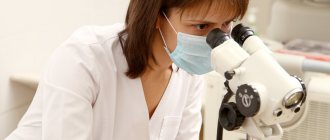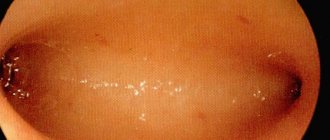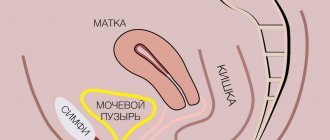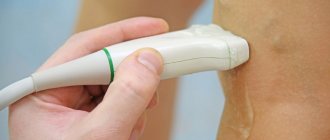Authors of the article: Candidate of Medical Sciences O.Yu. Ermolaev
Operating gynecologist, physiotherapist E.K. Ermolaeva
Make an appointment with a gynecologist
Here we are offered specialized treatment for the symptoms of uterine prolapse, rather than being placed directly on the operating table.
From patient reviews
Symptoms of uterine and vaginal prolapse in the vast majority of cases develop slowly and CONTINUALLY PROGRESS.
In rare cases, symptoms of acute uterine prolapse occur - with sudden straining, falling from a height onto your feet, unexpected strong shaking of the body, fright, etc.
ACUTE (suddenly occurring) uterine prolapse is manifested by the following SYMPTOMS: severe aching and/or CRACING PAIN in the lower abdomen with symptoms of shock (weakness, cold sweat, fainting, dizziness, vomiting).
WITH THE GRADUAL DEVELOPMENT of anatomical disorders, other SYMPTOMS OF uterine and vaginal prolapse occur.
- The most common symptom of uterine and vaginal prolapse is unexplained discomfort, a FEELING OF PRESSURE on the perineum (on the “bottom”) and ACHING PAIN in the lower abdomen and lower back of a constant or periodic nature, arising and/or INCREASED AFTER physical activity, WALKING, when coughing, laughing, sneezing , BY THE EVENING; without irradiation, stops (spontaneously) by lying down and raising the pelvis.
- A common symptom of uterine and vaginal prolapse is PAIN during sexual intercourse IN THE “WOMAN ON TOP” POSITION and with the legs adducted (pressed) to the stomach, relative comfort in positions on the side and stomach.
- THE LACK of a feeling of tight squeezing (envelopment) of the penis is ONE OF THE EARLIEST SYMPTOMS of prolapse of the uterus and vagina. In general, there is a DECREASE in SENSITIVITY and satisfaction with sexual intercourse in women (and men. What men most often discreetly keep silent about). About vaginal reduction WITHOUT SURGERY in detail...
- A symptom of prolapse of the uterus and the anterior vaginal wall is increased frequency and/or difficulty in URINATION.
- A symptom of prolapse of the uterus and the anterior wall of the vagina is URINARY INCONTINENCE during sexual intercourse and stress: coughing, laughing, sneezing, physical activity (walking, running, physical work). AFTER REPOSITIONING (removal) of the uterus to the correct anatomical position for 7 days of TREATMENT at the Resort Clinic women's health URINARY INCONTINENCE DISAPPEARS. About successful treatment of urinary incontinence in detail...
- A symptom of uterine prolapse is the NEED FOR PRESSURE with your hands ON THE BOTTOM OF THE ABDOMEN to completely empty the bladder.
- A symptom of prolapse of the posterior wall of the vagina and cervix is DIFFICULTY DEFECATION, constipation.
- A common symptom of uterine prolapse is constant viscous, transparent, odorless, mucous discharge from the vagina. The woman notes a FEELING of constant WETTERNESS in the vulva (external genitalia). AFTER REPOSITIONING the uterus to the correct anatomical position during 7 days of treatment in our Clinic, the mucous DISCHARGE DISAPPEARS on its own. In some cases,
- A symptom of uterine prolapse is BLOODY DISCHARGE from the genital tract due to physical activity.
- A symptom of uterine prolapse in many cases is heavy, often LONG MENSTRUATION due to congestion in the pelvis.
- A common symptom of uterine prolapse is DECREASED REPRODUCTIVE FUNCTION.
We often detect uterine prolapse in women who come to the Women's Health Resort Clinic for infertility treatment. About all the causes of infertility in detail... RAISING THE UTERUS TO THE CORRECT ANATOMICAL POSITION RESTORES reproductive function. About restoring the position of the uterus in detail... A decrease in the frequency of pregnancy is associated with the FLOW OF SPERM from the vagina due to gaping (opening, loose closure) of the genital slit (entrance to the vagina) and VIOLATION of the conditions for IMPLANTATION of the fertilized egg. The fertilized egg is, as it were, “squeezed out” from the uterine cavity due to increased intrauterine pressure. The resulting pregnancy can develop normally. During a 4-5 month pregnancy (at 16-20 weeks of pregnancy), the uterus enlarges significantly and does not prolapse. However, after childbirth, uterine and vaginal prolapse resumes and often worsens.
- A symptom of prolapse of the uterus and vagina is a FEELING OF HEAVYNESS (lack of the former girlish lightness).
- A symptom of uterine prolapse is the APPEARANCE of a specific female (“LOWER”) ABDOMEN due to pressure from the bladder on the abdominal wall. AFTER REPOSITIONING (removal) of the uterus to the correct anatomical position during 7 days of TREATMENT at the Women's Health Resort Clinic, the “lower” ABDOMEN DISAPPEARS. And the woman sadly recalls the diets she carried out and the time spent in the gym. About vaginal gymnastics in detail...
- A frequent and EARLY SYMPTOM of prolapse of the uterus and vaginal walls is the release of air from the vagina - a kind of “farting” when raising the pelvis, bringing (“pressing”) the legs to the stomach during physical activity and sexual intercourse.
- The least noticeable symptom of uterine prolapse is a CHANGE in the direction of the URINE STREAM anteriorly during urination. And only attentive women notice traces of urine that have inexplicably appeared on the rim and under the rim of the toilet...
| Photo of 1st degree uterine prolapse before treatment in our Clinic. Sticky, clear, mucous vaginal discharge is a common symptom of uterine prolapse |
Prolapse of the uterus is accompanied by a PERSISTENT (obsessive) DESIRE to tighten and TIPE up the BELLY with a scarf, a scarf, a belt and other available means.
Types of pelvic organ prolapse in women
Lateral anterior prolapse
- if the leading point of prolapse is the anterior wall of the vagina with the posterior wall of the bladder (cystocele).
Lateral posterior prolapse
- if the posterior wall of the vagina or the anterior wall of the rectum predominates.
Central or apical prolapse
- predominance of cervical prolapse, sagging of the vaginal vault.
When the uterus is removed and there is prolapse or sagging of intestinal loops through the vaginal stump, they speak of enterocele
as a variant of apical or central prolapse.
These terms are relative, but the definition of the predominant compartment is important when choosing the type of treatment.
The boundary of the exit of organs beyond the pelvis is the plane of the hymen or hymen. To understand how prolapse occurs, you need to understand the normal anatomy and mechanisms that keep the vagina in good condition.
Diagnostics
Diagnosis of uterine prolapse does not raise questions among specialists. To do this, it is necessary to conduct a standard gynecological examination, on the basis of which the stage of prolapse is set and the part of the vagina involved in the pathological process is determined.
Most often, damage occurs to all three sections of the pelvic floor: anterior, posterior and apical.
In total, there are four degrees of uterine prolapse: the first (initial), when the patient is practically not bothered by anything, the fourth degree is accompanied by complete prolapse of the pelvic organs.
The study can be supplemented with a digital rectal examination to exclude rectal prolapse.
As instrumental methods, ultrasound of the pelvic organs and sometimes MRI are performed.
| Most patients receive care for free (without hidden additional payments for “network”, etc.) as part of compulsory health insurance ( under the compulsory medical insurance policy ). | Application for treatment under compulsory medical insurance |
Anatomy of the pelvic organs in women
Anatomical support for the pelvic organs in women is provided by the interaction between the pelvic floor muscles and the connective tissue fascia and ligaments connecting the pelvic bones to the organs. Together, these muscles and ligaments provide stable support to the pelvic organs while maintaining elasticity. Also a powerful stabilizing factor is the complex of the uterosacral and cardinal ligaments of the uterus.
DeLancey Pelvic Support Levels:
First level
- this is the supporting apparatus of the uterus in the form of the uterosacral and cardinal ligaments, fixing the uterus and the upper third of the vagina to the sacrum and the lateral wall of the pelvis. They allow the uterus to be held upright. The destruction of these ligaments, for example, as a result of traumatic childbirth, leads to prolapse of the cervix, and then the entire uterus, along with the upper third of the vagina.
Second level
support - a complex of fascial structures lateral to the vagina or located along the length of the vagina and passing to the levators and the white line of the fascia of the pelvis. Damage to these structures leads to prolapse of the bladder and anterior vaginal wall.
Third level
– the body of the perineum, including the superficial and deep muscles of the perineum, supporting the distal third of the vagina. Damage to these structures anteriorly leads to hypermobility of the urethra, and posteriorly to a rectocele or prolapse of the posterior vaginal wall with the anterior wall of the rectum.
The innervation of the supporting apparatus through the spinal cord is important. Certain nerve fibers form the pudendal or pudendal nerve. The upper bundles of the pudendal nerve supply the levators, pubococcygeus muscle, and urogenital diaphragm, and below the pudendal nerve itself innervates the anal sphincter.
Operation
Of course, they will not replace damaged ligaments and fascia. Surgical treatment for severe forms of prolapse is the only effective treatment method. The most popular, studied and natural operations are those performed through the vagina. In this case, it is possible to restore all parts of the pelvic floor and achieve excellent cosmetic results with minimal risks for the patient.
hybrid techniques have become widespread.
, which allow you to restore the natural anatomy of the pelvic floor through a combination of organ-preserving techniques, maximum use of the patient’s own tissues and targeted/targeted use of synthetic materials in the busiest areas.
Risk factors for developing prolapse
Risk factors for pelvic organ prolapse in women include vaginal births and number of births, age and obesity. Risk factors for recurrence of prolapse after surgical correction include damage to the levator ani muscles, treatment of advanced forms of prolapse, and familial forms of the disease.
Number of births
The risk of prolapse increases with the number of vaginal births in history.
The Oxford Family Planning study, which followed more than 17,000 women for 17 years, found that compared with nulliparous women, the risk of hospitalization for prolapse increased markedly after the first (4-fold) and second (8-fold) birth. and then it grew more slowly: after the third birth by 9 times, the fourth by 10 times, and so on.
Factors associated with labor and the development of prolapse include high fetal birth weight, prolonged second stage of labor, and maternal age less than 25 years at first birth. However, vaginal prolapse can also occur in nulliparous women.
Elderly age
The risk of developing prolapse increases with age.
In the Women's Health Initiative study (more than 27,000 women), there was a small but statistically significant progressive increase in the prevalence of rectocele with age (50 to 59 versus 60 to 69 and 70 to 79 years).
Obesity
Women who are overweight (BMI ≥25–29.9 kg/m2) and obese (BMI ≥30 kg/m2) have an increased risk of developing prolapse compared to their normal-weight counterparts. However, whether weight loss leads to regression of prolapse remains controversial, but there are reports of regression of prolapse in women after bariatric surgery.
Hysterectomy
The role of hysterectomy in the development of subsequent pelvic organ prolapse is controversial. The risk may depend on age, presence of prolapse before hysterectomy, and surgical approach.
Retrosymphyseal urethropexy or "suspension" procedure
(fixation of the uterus to the posterior surface of the symphysis pubis) can lead to a greater anterior deviation of the anterior vaginal wall, which changes the distribution of force along all vaginal walls. As a result, the apex and posterior wall of the vagina may become prone to the development of support defects, including enterocele or rectocele.
Increased intra-abdominal pressure
Chronic constipation and other conditions that cause repeated increases in intra-abdominal pressure, such as chronic obstructive pulmonary disease, can stretch and damage the pudendal nerve.
There is currently no reliable data regarding whether the risk of prolapse is increased in women who lift weights. One study of more than 1,000 women found that women doing physically demanding jobs had significantly more severe prolapses than other categories of women.
Connective tissue pathology
Some connective tissue diseases (eg, Ehlers-Danlos syndrome) or congenital abnormalities (eg, bladder exstrophy) contribute to the development of prolapse. Women with hypermobile joints have a higher prevalence of prolapse than women with normal joint mobility.
Family history
Potential genes and patterns of inheritance are unknown. Most likely, we are talking about connective tissue dysplasia as the cause of prolapse.
Causes of the disease
The cause of the disease can be different and it depends on both external and internal factors. One of the most common reasons that leads to prolapse is the inability of the muscles and ligamentous apparatus to perform certain functions that contribute to their weakening. Also, uterine prolapse in the elderly and women of other ages occurs due to wear and tear of the muscles, increased pressure in the inner part of the abdominal cavity, genetic predisposition and certain features in the formation of the reproductive organs and physique. Due to the fact that uterine prolapse in old age occurs due to increased intra-abdominal pressure, the occurrence of this process can be facilitated by:
- excessive tension of the abdominal muscles followed by severe asthmatic cough;
- carrying out a difficult birth, during which the woman had to push for too long;
- repeated births, after which the organ gradually stretches and lengthens;
- excessive cycling or weightlifting;
- presence of constant constipation;
- performing very heavy loads that are beyond the strength of a woman.
Also, ligaments and muscles can weaken due to the fact that there is a decreased production of hormones of the female reproductive system. This often happens during menopause or in older women. In addition, previous surgery or inflammatory diseases can contribute to muscle strain and further prolapse.
Symptoms of pelvic organ prolapse in women
- sensation of a foreign body and heaviness in the perineum, discomfort in the vagina
- urination disorders (cystocele and urethrocele): frequent urination, lack of satisfaction with the act of urination, urge to urinate, urinary incontinence when coughing and any exertion, etc.
- disorders of defecation and stool (rectocele, enterocele, sigmoidocele, perineocele, rectal prolapse): fecal incontinence, rectal bleeding.
- sexual dysfunction.
Low back or pelvic pain is often associated with prolapse, but studies have not confirmed this association.
Symptoms of prolapse are often related to body position: they are less noticeable in the morning or when lying on the back and worsen during the day when women are active and upright.
Many women with prolapse have no symptoms and treatment is usually not indicated. Some women themselves see the protrusion of organs beyond the genital opening.
Symptoms
Symptoms of the disease directly depend on the organ that was involved in the pathological process. Taking this fact into account, the following symptom complexes can be identified:
- Associated with bladder prolapse: Difficulty urinating, feeling of incomplete emptying of the bladder, frequent urination, urination in small portions, sudden (imperative) urge to urinate, loss of urine due to physical activity or urgency
- Associated with rectal prolapse: difficulty defecating, the need to help with your hand (press on the prolapsed vaginal walls) during defecation.
- Associated with uterine prolapse: nagging pain in the lower abdomen, discomfort during sexual intercourse.
At the same time, the main symptom characteristic of all patients and leading them to the doctor is the feeling of a foreign body in the vagina. Moreover, most patients have a violation of the support of several organs at once, and therefore the clinical picture may be more multifaceted than described above.
| anonymously to the doctor, through the feedback form, we will try to help you. | Ask a Question |
Treatment
Treatment is indicated for women with symptoms of prolapse or symptoms accompanying prolapse (impaired urination and bowel movements or sexual dysfunction).
Establishing the patient's goals is central to determining treatment tactics. The method is selected individually in accordance with the symptoms and their impact on the quality of life. It is important to set realistic expectations, taking into account comorbid medical conditions that influence the perception of symptoms.
The choice of therapy depends on the woman's preferences, as well as her ability to comply with recommended conservative therapy (usually exercise) or undergo surgery.
Watchful waiting is a suitable option for women who are not very concerned about their symptoms and can wait until they decide to undergo surgery. However, patients with grade 3 or 4 prolapse are at risk of additional problems with urination and bowel movements, and therefore regular monitoring is recommended.
Vaginal pessaries
The main alternative to prolapse surgery is the use of vaginal pessaries.
Pessaries are silicone devices of various shapes and sizes that support the pelvic organs. Pessaries should be removed and cleaned regularly.
Pelvic floor muscle training (Kegel exercises).
Randomized trials have demonstrated the benefits of such exercises, especially when individually taught and/or supervised. Therefore, biofeedback therapy has become widespread. The lower the degree of prolapse, the more effective the training programs are.
Estrogen therapy
There are no data to support the use of systemic or topical estrogen as primary therapy for prolapse. At the same time, the introduction of estrogen into the vagina in the perioperative period increases the production of mature collagen, increases the thickness of the vaginal wall and reduces the activity of degradative enzymes.
Surgery
Candidates for surgical treatment are women with symptoms of prolapse who cannot perform conservative measures or consciously refuse them.
Surgeries for pelvic organ prolapse are performed through vaginal and abdominal approaches using local tissues and synthetic materials.
The choice of surgical approach depends on the severity of symptoms, the extent of the prolapse, the experience of the surgeon, and the patient's expectations. One of the problems with prolapse surgery is the recurrence rate. The risk of re-surgery when using local tissues, according to various sources, reaches 30%. Therefore, technologies using synthetic prostheses have found wide application
Sacrocolpopexy and strengthening of the middle third of the urethra are methods that have proven effective when using mesh materials. Other technologies, especially the use of synthetic materials through vaginal access, are controversial and even “forbidden” in different countries.
Thus, the use of local tissues and a suburethral sling for vaginal access, as well as sacrocolpopexy and Burch’s operation (fixation of the anterior vaginal wall to the Cooper ligament of the pubic bone through access to the space of Retzius) for abdominal access are considered today as operations that have proven their validity in accordance with with clinical international recommendations.
Prolapse of the vagina and uterus: treatment, initial appointment
At the initial appointment, the doctor examines the vagina and collects information about the patient’s condition. Already during the examination, the doctor will be able to assess the degree of development of the disease and give directions for treatment or additional diagnostics.
To one degree or another, upon examination one can determine:
- location of uterine or vaginal prolapse;
- condition of the muscles and ligaments of the pelvic floor;
- stage and nature of the violations;
- physiological causes of prolapse or prolapse, etc.
The doctor will also ask questions about your health status and possible causes that led to this disease.
Diagnosis of the disease
For each specific clinical case, the doctor prescribes tests and gives directions for diagnosis, which may include:
- Ultrasound
(with two sensors - transabdominal and transvaginal) of the pelvic organs (uterus,
kidneys, bladder
); - hormonal tests;
- urine tests for infections;
- other tests and examinations.
Treatment plan for prolapse or prolapse of the uterus (vagina)
There are several ways to deal with this problem. The doctor can use one of them already at the initial examination, if the stage of the disease and the patient’s condition allows it. We are talking about wearing a special uterine ring (pessary), which supports the uterus and prevents it from falling below a specific level.
It should be noted that the pessary is not intended to treat uterine prolapse, like other methods, but it can eliminate a number of symptoms and significantly improve the patient’s quality of life. In some cases, a pessary is prescribed to prevent prolapse during physical activity or before long walks, for example.
Methods for treating uterine prolapse (walls, cervix):
- Physical therapy (one of the methods is Kegel exercises) is prescribed when the patient has minor symptoms of prolapse and when there are no individual contraindications. This form of treatment can completely cure the patient and normalize the quality of life. A massage may also be prescribed.
- Surgical treatment (vaginoplasty) is prescribed when it is impossible to maintain the pelvic organs with the help of physical exercises or using medications (this is possible when the uterus prolapses after childbirth).
- Hormone replacement therapy is most often prescribed for estrogen deficiency (menopause). These can be either vaginal creams or suppositories.
If other diseases, such as infections, were identified during the diagnosis, then additional drug treatment is prescribed. Since cervical prolapse can cause emotional discomfort, and not just physical, it is possible to prescribe consultations with a psychotherapist or psychologist.
Repeated appointment
The doctor monitors the treatment of each individual patient, therefore, after a period of time after the start of treatment, which is determined by the doctor, a second appointment is scheduled to evaluate the progress of treatment.
If, based on the results of the examination, it becomes clear that everything is fine, then the patient is sent home with instructions for physical therapy and recovery until the control appointment. If the examination does not show the necessary improvements, then it is possible to prescribe additional examinations and draw up new treatment regimens to determine why the previous course did not work, how to treat uterine prolapse and what to do next. An individual schedule for follow-up visits is also drawn up.
Control reception
A follow-up appointment is scheduled after the end of treatment to ensure that the treatment has a long-term effect. The patient is invited for an appointment after 21–30 days or several months, depending on how complex the disease was.
Treatment result
Prolapse (prolapse) of the pelvic organs is completely cured or (in particularly difficult cases) a significant improvement in the condition is achieved. The timing of treatment and full recovery is strictly individual. If sexually transmitted infections were identified during diagnosis, treatment (for infections) is also prescribed to the partner.
Prevention
To avoid this pathology, you must adhere to simple and accessible rules:
- compliance with the diet (correct and rational selection of products);
- weight control;
- physical activity (moderate, or only physical therapy);
- do not lift heavy objects (more than 5 kg).
And don’t forget to get into the habit of regularly visiting your gynecologist.
: this helps prevent the emergence and development of various diseases and pathologies of the genitourinary system.
One of the main misconceptions that concerns women's health and this particular pathology is that many, having discovered prolapse or prolapse of the genital organs, are in no hurry to go to the doctor, because it does not bother them much. But, like any other disease, genitourinary organ prolapse can gradually worsen, leading to more complex and expensive treatment. Therefore, you should definitely go to the doctor.
You can only get more information useful for your case by consulting with a specialist. We invite you to make an appointment with any of the doctors at our center by calling the number listed on this page or through the online registration form.
Prevention of prolapse
Strategies for preventing prolapse and its progression have not been sufficiently studied. There is evidence that the following can help prevent prolapse:
- vaginal pessary,
- weight loss,
- treatment of chronic constipation,
- refusal of hard physical work,
- estrogens or drugs with estrogenic effects alone or in combination with other treatments,
- postpartum rehabilitation.
Although vaginal birth is associated with an increased risk of prolapse, it is not clear whether a cesarean section will prevent it from occurring.
Postpartum rehabilitation to restore muscle tone, the use of exercise equipment, biofeedback therapy for minimal degrees of prolapse, preventive mini-surgical vaginal plastic surgery are procedures aimed not only at the aesthetic restoration of the perineum, but also to prevent the progression of prolapse and the need for more complex surgical interventions in case of relapses.











